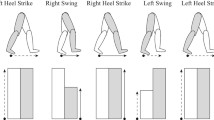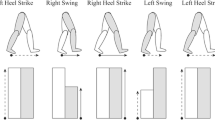Abstract
The incorporation of real-time visual feedback during gait rehabilitation can improve the efficacy of training. Our prior work demonstrated that the imposed distortion of simple visual feedback information of step lengths entails an unintentional adaptive process in the subjects’ spatial gait pattern, thereby suggesting the important role of implicit learning in the context of gait rehabilitation that employs visual feedback. The purpose of this study was to investigate whether the removal of a portion of visual feedback information—after it had initially been provided—had any impact on gait symmetry. Eighteen healthy subjects walked on a treadmill for 10-min periods at their preferred walking speed and at a slower walking speed (1.3 mph) during the experimental trials, in which two simple vertical bars corresponding to subject’s right and left step length were displayed on a computer screen. Halfway through the trial, one of the bars was removed from the visual feedback via random selection. Subjects were instructed to continually walk normally and also look at the visual feedback until the trials were completed. The changes in step length symmetry ratio were computed and analyzed. We found that displaying only one side of visual feedback influenced subjects to spontaneously modulate gait symmetry away from the baseline, and also that the amount of modulated gait symmetry slightly increased when their walking speed decreased. The changes in gait symmetry occurred by producing either longer right steps produced than left steps or vice versa, but we were unable to find any correlation between side of removal (right or left side) and the different types of trend in response. This warrants further investigation in a study with a larger population. Nonetheless, the results of this study demonstrated the effect of partial absence of visual feedback on changes in step symmetry, and that the perturbation of visual information caused implicit (unintentional) motor processes. A gait training procedure involving a novel way of perturbing visual feedback, such as partial absence of visual feedback tested in this study, may be of value in gait rehabilitation by driving more efficient motor adaptations.




Similar content being viewed by others
References
Balasubramanian, C. K., Bowden, M. G., Neptune, R. R., & Kautz, S. A. (2007). Relationship between step length asymmetry and walking performance in subjects with chronic hemiparesis. [Research Support, N.I.H., Extramural Research Support, U.S. Gov’t, Non-P.H.S.]. Archives of Physical Medicine and Rehabilitation, 88(1), 43–49. doi:10.1016/j.apmr.2006.10.004.
Bedford, F. L. (1999). Keeping perception accurate. Trends in Cognitive Sciences, 3(1), 4–11.
Bronstein, A. M., Bunday, K. L., & Reynolds, R. (2009a). What the “broken escalator” phenomenon teaches us about balance. [Review]. Annals of the New York Academy of Sciences, 1164, 82–88. doi:10.1111/j.1749-6632.2009.03870.x.
Bronstein, A. M., Bunday, K. L., & Reynolds, R. (2009b). What the “broken escalator” phenomenon teaches us about balance. Annals of the New York Academy of Sciences, 1164, 82–88.
Cho, K. H., & Lee, W. H. (2013). Virtual walking training program using a real-world video recording for patients with chronic stroke: A pilot study. [Comparative Study Randomized Controlled Trial]. American Journal of Physical Medicine & Rehabilitation/Association of Academic Physiatrists, 92(5), 371–380. doi:10.1097/PHM.0b013e31828cd5d3 (quiz 380–372, 458)
Crowell, H. P., Milner, C. E., Hamill, J., & Davis, I. S. (2010). Reducing impact loading during running with the use of real-time visual feedback. [Evaluation Studies]. The Journal of Orthopaedic and Sports Physical Therapy, 40(4), 206–213. doi:10.2519/jospt.2010.3166.
Hendrickson, J., Patterson, K. K., Inness, E. L., McIlroy, W. E., & Mansfield, A. (2014). Relationship between asymmetry of quiet standing balance control and walking post-stroke. [Research Support, Non-U.S. Gov’t]. Gait & Posture, 39(1), 177–181. doi:10.1016/j.gaitpost.2013.06.022.
Hornby, T. G., Campbell, D. D., Kahn, J. H., Demott, T., Moore, J. L., & Roth, H. R. (2008). Enhanced gait-related improvements after therapist-versus robotic-assisted locomotor training in subjects with chronic stroke: A randomized controlled study. Stroke; A Journal of Cerebral Circulation, 39(6), 1786–1792.
Jorgensen, L., Crabtree, N. J., Reeve, J., & Jacobsen, B. K. (2000). Ambulatory level and asymmetrical weight bearing after stroke affects bone loss in the upper and lower part of the femoral neck differently: Bone adaptation after decreased mechanical loading. [Research Support, Non-U.S. Gov’t]. Bone, 27(5), 701–707.
Kim, S. J., & Krebs, H. I. (2012). Effects of implicit visual feedback distortion on human gait. [Research Support, Non-U.S. Gov’t]. Experimental Brain Research. Experimentelle Hirnforschung. Experimentation Cerebrale, 218(3), 495–502. doi:10.1007/s00221-012-3044-5.
Kim, S. J., & Mugisha, D. (2014). Effect of explicit visual feedback distortion on human gait. Journal of Neuroengineering and Rehabilitation, 11(1), 74. doi:10.1186/1743-0003-11-74.
Kim, S. J., Ogilvie, M., Shimabukuro, N., Stewart, T., & Shin, J. H. (2015). Effects of visual feedback distortion on gait adaptation: Comparison of implicit visual distortion versus conscious modulation on retention of motor learning. [Research Support, Non-U.S. Gov’t]. IEEE Transactions on Bio-medical Engineering, 62(9), 2244–2250. doi:10.1109/TBME.2015.2420851.
Kitago, T., & Krakauer, J. W. (2013). Motor learning principles for neurorehabilitation. [Review]. Handbook of Clinical Neurology, 110, 93–103. doi:10.1016/B978-0-444-52901-5.00008-3.
Krebs, H. I., Volpe, B. T., Aisen, M. L., & Hogan, N. (2000). Increasing productivity and quality of care: Robot-aided neuro-rehabilitation. Journal of Rehabilitation Research and Development, 37(6), 639–652.
Malone, L. A., & Bastian, A. J. (2010). Thinking about walking: Effects of conscious correction versus distraction on locomotor adaptation. [Randomized Controlled Trial Research Support, N.I.H., Extramural]. Journal of Neurophysiology, 103(4), 1954–1962. doi:10.1152/jn.00832.2009.
Malone, L. A., & Bastian, A. J. (2014). Spatial and temporal asymmetries in gait predict split-belt adaptation behavior in stroke. [Research Support, N.I.H., Extramural]. Neurorehabilitation and Neural Repair, 28(3), 230–240. doi:10.1177/1545968313505912.
Martin, T. A., Keating, J. G., Goodkin, H. P., Bastian, A. J., & Thach, W. T. (1996). Throwing while looking through prisms. II. Specificity and storage of multiple gaze-throw calibrations. [Research Support, Non-U.S. Gov’t Research Support, U.S. Gov’t, Non-P.H.S.Research Support, U.S. Gov’t, P.H.S.]. Brain: A Journal of Neurology, 119(Pt 4), 1199–1211.
Mazzoni, P., & Krakauer, J. W. (2006). An implicit plan overrides an explicit strategy during visuomotor adaptation. The Journal of Neuroscience: The Official Journal of the Society for Neuroscience, 26(14), 3642–3645.
Noble, J. W., & Prentice, S. D. (2006). Adaptation to unilateral change in lower limb mechanical properties during human walking. Experimental Brain Research, 169(4), 482–495.
Pailhous, J., Ferrandez, A. M., Fluckiger, M., & Baumberger, B. (1990). Unintentional modulations of human gait by optical flow. Behavioural Brain Research, 38(3), 275–281.
Patla, A. E. (1998). How is human gait controlled by vision? Ecological Psychology, 10(3–4), 287–302.
Patterson, K. K., Parafianowicz, I., Danells, C. J., Closson, V., Verrier, M. C., Staines, W. R., et al. (2008). Gait asymmetry in community-ambulating stroke survivors. [Research Support, Non-U.S. Gov’t]. Archives of Physical Medicine and Rehabilitation, 89(2), 304–310. doi:10.1016/j.apmr.2007.08.142.
Plummer, P., Behrman, A. L., Duncan, P. W., Spigel, P., Saracino, D., Martin, J., et al. (2007). Effects of stroke severity and training duration on locomotor recovery after stroke: A pilot study. Neurorehabilitation and Neural Repair, 21(2), 137–151.
Prokop, T., Schubert, M., & Berger, W. (1997). Visual influence on human locomotion. Modulation to changes in optic flow. Experimental Brain Research, 114(1), 63–70.
Rendell, M. A., Masters, R. S., Farrow, D., & Morris, T. (2011). An implicit basis for the retention benefits of random practice. Journal of Motor Behavior, 43(1), 1–13. doi:10.1080/00222895.2010.530304.
Rosati, G., Roda, A., Avanzini, F., & Masiero, S. (2013). On the role of auditory feedback in robot-assisted movement training after stroke: Review of the literature. [Review]. Computational Intelligence and Neuroscience, 2013, 586138. doi:10.1155/2013/586138.
Rossignol, S. (1996). Visuomotor regulation of locomotion. Canadian Journal of Physiology and Pharmacology, 74(4), 418–425.
Thikey, H., Grealy, M., van Wijck, F., Barber, M., & Rowe, P. (2012). Augmented visual feedback of movement performance to enhance walking recovery after stroke: Study protocol for a pilot randomised controlled trial. [Randomized Controlled TrialResearch Support, Non-U.S. Gov’t]. Trials, 13, 163. doi:10.1186/1745-6215-13-163.
Winstein, C. J. (1991). Knowledge of results and motor learning–implications for physical therapy. Physical Therapy, 71(2), 140–149.
Wuehr, M., Schniepp, R., Pradhan, C., Ilmberger, J., Strupp, M., Brandt, T., et al. (2013). Differential effects of absent visual feedback control on gait variability during different locomotion speeds. [Research Support, Non-U.S. Gov’t]. Experimental Brain Research, 224(2), 287–294. doi:10.1007/s00221-012-3310-6.
Young, D. E., & Schmidt, R. A. (1992). Augmented kinematic feedback for motor learning. Journal of Motor Behavior, 24(3), 261–273.
Funding
This study was funded by an internal funding source (Faculty Developmental Fund from California Baptist University, Microgrant 2014–2015).
Author information
Authors and Affiliations
Corresponding author
Ethics declarations
Conflict of interest
The authors declare that there is no conflict of interest regarding the publication of this paper.
Ethical Approval
All procedure performed in studies involving human participants were in accordance with the ethical standards of California Baptist University Institutional Review Board.
Informed Consent
Informed consent was obtained from all individual participates included in the study.
Rights and permissions
About this article
Cite this article
Kim, SJ., Kayitesi, M.A., Chan, A. et al. Effects of Partial Absence of Visual Feedback Information on Gait Symmetry. Appl Psychophysiol Biofeedback 42, 107–115 (2017). https://doi.org/10.1007/s10484-017-9358-0
Published:
Issue Date:
DOI: https://doi.org/10.1007/s10484-017-9358-0




